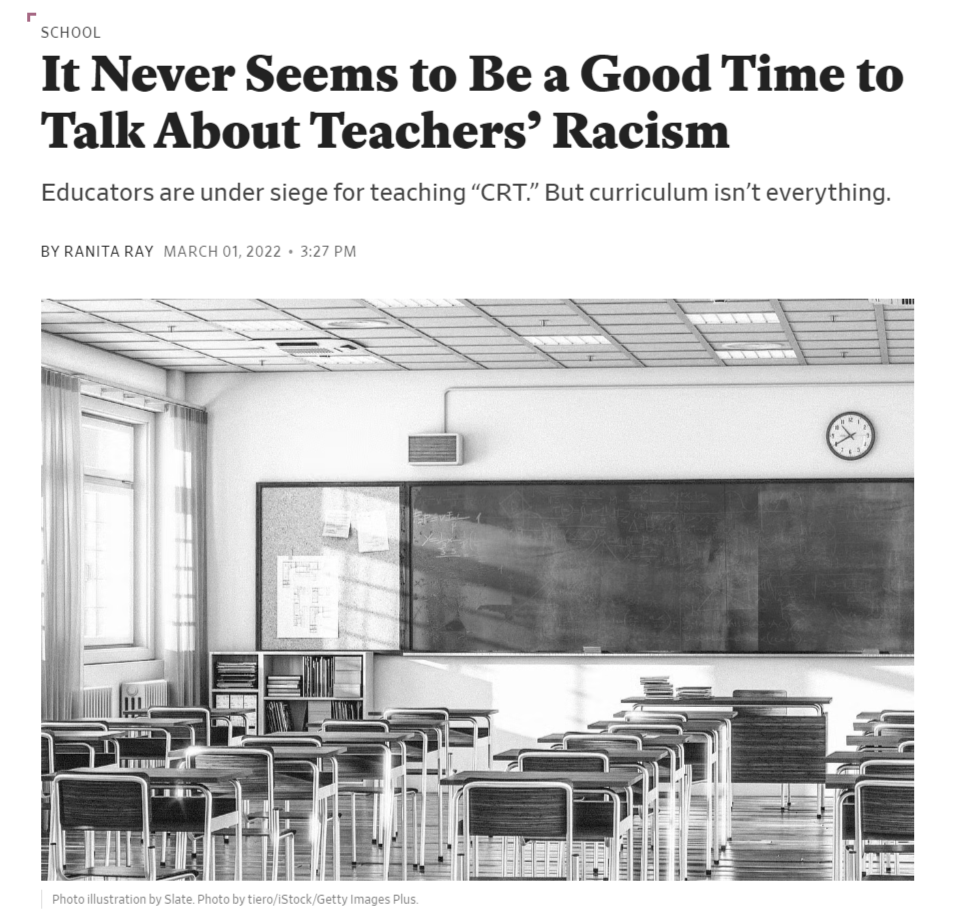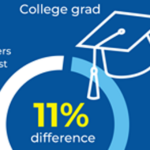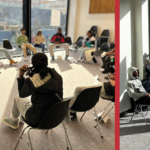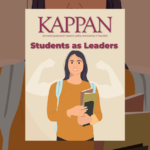The “slow violence” of everyday teacher racism rarely gets the attention it warrants.
By Ranita Ray
Between 2017 and 2020, I spent most of my weekdays inside 4th, 5th, and 6th grade classrooms in one of the nation’s largest school districts.
Over the three years, I followed a 4th grade cohort of 80 into 6th grade, sat inside 15 classrooms with them, spoke with their teachers, and heard from admins across the district. The district and schools where I spent my time served primarily Black, Latinx, and immigrant students.
I had embarked upon this immersive field research anticipating writing a book on resource-strapped school districts, overwhelmed teachers, tyrannical testing regimes, and other such conversations that dominate media, public, and policy discourse on schools.
Instead, I feel compelled to tell a story about schools that is deeply uncomfortable for many and nearly dangerous in a moment when we are witnessing a resurgence of right-wing anti-public education movement: the “slow violence” of everyday teacher racism in American classrooms.
For my project, titled “Violent Schools: Slow Death in the American Classroom,” I was recently named a finalist for the Lukas Prize for nonfiction works in progress.
I feel compelled to tell a story about the “slow violence” of everyday teacher racism.
I was not surprised by the presence of teacher racism and harassment against marginalized students in a district where over 75% of teachers are white (and over 80% of students are racially marginalized).
But the regularity and magnitude signaled to me that I urgently needed to bring this conversation into the academic, public, and policy discourse.
Issues of teacher racism and everyday, wide-ranging harassment of marginalized kids — Black, immigrant, trans, fat, disabled children — do not get the coverage they urgently need.
There is occasional news coverage and X discourse, but teacher racism is rarely given the gravity we assign to other issues.
Teacher racism is rarely given the gravity we assign to other issues.
What do I mean by pervasive teacher racism? Harassment that is against students from racially oppressed groups and that draws upon and perpetuates racist discourses and ideologies.
My research revealed that teacher racism cannot be simply understood as implicit or unconscious bias or institutional failings — the most common ways we are urged to think about racism.
What does teacher racism look like in real life?
- A fourth-grade teacher who openly resents the multicultural training required of teachers and argues for a white history month.
- An academically capable Black 5th grader who is denigrated simply because she likes to dress up.
- A Black boy who is shamed and becomes a subject of disgust because he gave affectionate hugs to his teachers (who, ironically, regularly hug their students).
- An English learner who is told she doesn’t speak well enough to participate in the class discussion.
- Teachers who berate Colin Kaepernick and other contemporary Black activists when teaching about the history of Civil Rights.
However, my media story searches on the topic of teacher racism came up severely short. Serious and thoughtful coverage of this is largely absent.
There is occasional coverage of egregious racial harassment — a teacher walking on the backs of Black children during a lesson on slavery or teachers dressing up as a “wall” for Halloween or teachers physically harming a disabled child. There are also instances of children resisting teacher racism and protesting.
Yet a serious, ongoing, and in-depth conversation on the topic is rare from what I have seen and read.
A serious conversation on the topic is rare.
This doesn’t surprise me because part of the story of everyday racial violence is one of its erasures from public consciousness through overwhelming silence from both journalists and scholars, or through writing on the topic in passive ways.
For instance, whenever I tell the story of teacher racism inside academic settings, the responses are generally predictable. A large portion of the white audience, whether I am doing a talk at a university or socializing at a bar, tend to stiffen up and become emotional and uncomfortable. A senior white faculty member at a well-renowned university questioned my intentions behind talking about teacher racism when teachers are often attacked and neglected.
Often, the only way to talk about teacher racism is through intuitional racism or implicit bias. Legal scholar Jonathan Kahn suggested in his book that implicit bias is a palatable way to talk about racism, hence its popularity. In my other academic writing, I have talked about the rise of a race-conscious racism where teachers and admins mobilize antiracist and implicit bias language to perpetuate racial harm.
Scholarly analyses of the classroom, like journalistic accounts of schools, is overwhelmingly devoid of direct conversations around teacher racism and racial and gender harassment against marginalized public school students from a largely white teaching force and administrators. There are, of course, exceptions, such as Michael Dumas’s work.
But when there is talk of racial inequality inside schools, there is a tendency to think about racism only at the institutional level — like how school protocols and policy funnel white students into AP classes or how funding creates resource obstacles for marginalized students or how teachers unknowingly interpret rules and regulations to reproduce racial hierarchy.
There is pressure to never talk about white teachers as agentic beings who make decisions to cause harm, demean and harass students, remain silent on issues of racial harassment, or even feel resentful toward multicultural curriculum and other antiracist pedagogical approaches.
On the other hand, the Black, brown, immigrant, trans, and fat audience nod their heads in agreement when I talk about the topic. They tell me a story they remember when a teacher harassed them or demeaned them.

Above: Ray described “rampant racism, cruelty, and indifference from teachers working inside public schools” in this 2022 Slate article.
When I wrote a piece on teacher racism for Slate (above), well-renowned Black journalist Jamelle Bouie circulated it via his newsletter, and the discourse on X reflected my experience in the non-virtual world.
Many Black, brown, immigrant, and some white readers (including a few teachers who wrote to me bemoaning how their own school is replete with this problem) commiserated.
But the narrative is not something that generated widespread interest or attention.
Not unlike socio-cultural scholars studying schools, journalists covering education tend to be overwhelmingly white.
They may feel personally implicated when the topic of teacher racism comes up, especially when it is pervasive.
Many know or love someone — a wife, mother, sibling, cousin, best friend — who is a teacher. That person is probably also white.
After all, nearly 80% of the U.S. public school teaching force is also white.
Journalists may feel personally implicated when the topic of teacher racism comes up.
Since I left the children I had spent nearly every day with for three years, two defining global and national events — the COVID-19 pandemic and the resurgence of right-wing attack on public education — have unfolded and thrown into sharp relief the media’s silence and complicity on teacher racism.
When COVID shut down schools, conversations underlined the dangers that staying at home and in their neighborhoods all day posed for racially and economically marginalized students. Casting schools as the safe haven, journalists, scholars, and policymakers bemoaned the rising suicide rates, descending grades, and child abuse that would befall the children in the absence of peering eyes of white teachers.
Of course, I don’t disagree that many children (and adults) suffered when they were suddenly pulled away from their daily routine. On the other hand, many parents of Black children, for example, witnessed teachers’ anti-Black harassment when classes were held via Zoom or when teachers and admins forgot to turn off their mic.
Many Black and other people of color began to notice the improved emotional wellbeing of their children when they were home and took up homeschooling in response. In fact, there is also research on the experiences of racial harassment against Black and Latinx teachers, which partly keeps the teaching force white — something that I also found in my own research.
Yet this side of marginalized children’s school experience was overshadowed by the pressure to refrain from criticizing teachers. A conversation on the topic could have allowed us to take COVID school closures as an opportunity to rethink how we teach our children.
Many parents of Black children witnessed teachers’ anti-Black harassment when classes were held via Zoom.
Once again, as right-wing attacks on schools and public educators resurge, there is a push to remain silent on the issue of teacher racism.
These days, when I deliver talks on the topic of school violence perpetuated every day against children by teachers and admins, I am warned to be careful. I am interrogated on what steps I would take to ensure teachers are not attacked.
Indeed, I am afraid that my work has the potential to be mobilized to attack teachers and attack unions. But the truth is that this culture war that we think has entered our schools now was already raging inside.
The list is endless, but it was clear during my research that there is a need to talk about how teachers are teaching (our nation’s history and contemporary realities) and treating children of color behind closed classroom doors. We need to examine how antiracism training and multicultural pedagogical approaches are playing out inside the classroom.
The current urgent need to fight against book bans and attacks on educators is indeed a devastating derailment, but it can also be envisioned as a moment to rethink schooling and see the connection between growing attacks on public education and the internal cultural war that was already raging.
Ranita Ray is an author, ethnographer, and sociologist who is currently Associate Professor and Baca Zinn Professor of Sociology at the University of New Mexico. For “Violent Schools: Slow Death in the American Classroom,” she was recently named a finalist for the Lukas Prize for nonfiction works in progress. Read more about her work here. Follow her at @ranitaray1.
Previously from The Grade
Fear, complicity, and guilt get in the way of covering school segregation
Why education reporters need antibias training
No, asking questions about remote learning isn’t ‘teacher bashing’
Lessons from the media’s coverage of the 1996 Ebonics controversy
New York City 1968 was a community insurrection, not a teachers strike
White media barely noticed when 100,000 Black educators were displaced












